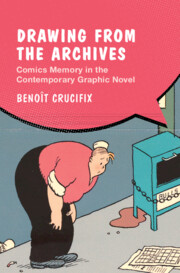
Since the first uses of the term in the 1970s, the graphic novel has been a concept in constant debate and evolution, capturing the new developments and mutations of comics across the last decades, alongside the concerns and enthusiasms such changes generate. At times blindly embraced, at other times vehemently rejected, the term has now become an integral part of the comics landscape and its study. Jan Baetens and Hugo Frey’s The Graphic Novel: An Introduction provided an accessible cornerstone for an open definition and an encompassing approach that, followed up by The Cambridge History of the Graphic Novel, demonstrated the complexities of the graphic novel, which cannot be quickly reduced to a strict set of defining features but should be grasped as a dynamically evolving form and format. Drawing from the Archives: Comics Memory in the Contemporary Graphic Novel hopes to make an original contribution to our understanding of the North-American graphic novel and its history not by studying its origins and its rise, its specific features and its innovations, but by analyzing its relationship to the past and to comics history.
While the graphic novel has often been presented and celebrated as something radically new and different, Drawing from the Archives shows that this newness cannot be severed from a profound relationship to older forms and a reflexive relationship to past comics. Starting from Spiegelman’s oft-quoted aphorism “the future of comics is in the past”, the book considers how the graphic novel has reshuffled the cards of comics history, with major cartoonists as Chris Ware, Art Spiegelman, Seth, Charles Burns, Daniel Clowes digging into comics archives to recover a common visual heritage and pass it on to new readers. It captures a deep interplay between new and old, innovation and tradition, rupture and continuity at the heart of the graphic novel.
One of its aims is to complicate a linear perspective on comics history as a series of neatly distinguished periods by stressing how each moment condenses multiple temporalities. Past works are not confined to their publication dates and often travel across time. While circulation has become a keyword in comics studies, it is often studied as a spatial rather than a temporal phenomenon. By contrast, Drawing from the Archives considers the recirculation of past works in the present, scrutinizing the material processes of transmission that shape how older comics are used, read, reproduced, redistributed, redrawn, rediscovered, reframed, dismantled, neglected, and so on. It implies a twofold perspective as it matters to analyze the retrospective look in the graphic novel alongside the history of techniques of inscription, preservation, and transmission that have made this archival turn possible.
The importance of newspaper comic strip in the graphic novel, for instance, has a lot to do with previous acts of transmission that brought this heritage to contemporary cartoonists. Conversely, exhibiting an original page from Winsor McCay’s Little Nemo is altogether different from scanning it and disseminating it online, reprinting an entire volume of the series at scale, copying, referencing or remixing McCay’s most iconic panels. All of these practices compound with questions of formats, make selective choices, imbue different sets of value. Contemporary cartoonists, when engaging with comics archives, are continuously negotiating with questions of historicity and memory.
Building on a previous framing of comics memory in terms of archives and styles, this book studies how contemporary cartoonists draw from the archives of comics, examining the specific practices of collection, reproduction, exhibition, imitation and appropriation that impart different ways of engaging with past comics. Each chapter accordingly focuses on a distinct ‘gesture of transmission’, stressing out the performative dimension of such actions: collecting, curating, reprinting, forging, swiping, and undrawing embody different ways old comics are remediated, reframed, and recirculated in the contemporary graphic novel. This broad approach thus encompasses both institutionalized settings – archives, libraries, museums, galleries, the publishing world – as well as vernacular practices of memory-making. It moves from exhibitions and lavish reprints to online databases and remixes. The archival turn in comics is one where the boundaries between archiving and making are constantly crisscrossing.
Credit line: Chris Ware, detail from the inside back cover of Drawn & Quarterly, no. 3 (Montreal: Drawn & Quarterly, 2000). Tribute to Frank King’s Gasoline Alley. Courtesy of the author.

Drawing from the Archives
by Benoît Crucifix
Latest Comments
Have your say!